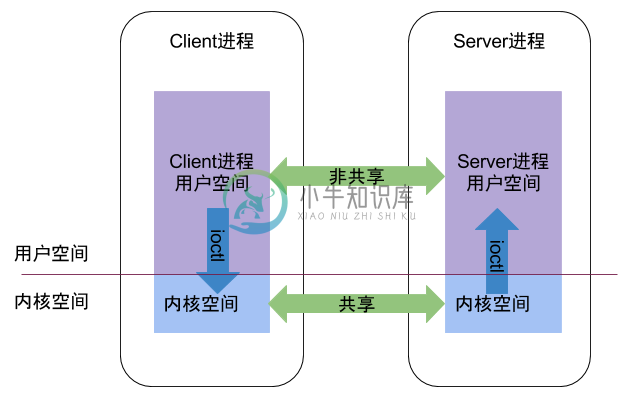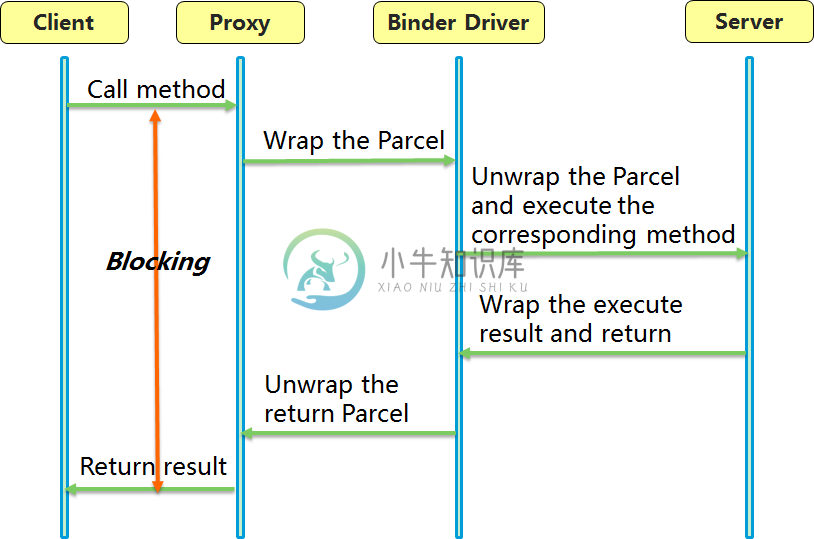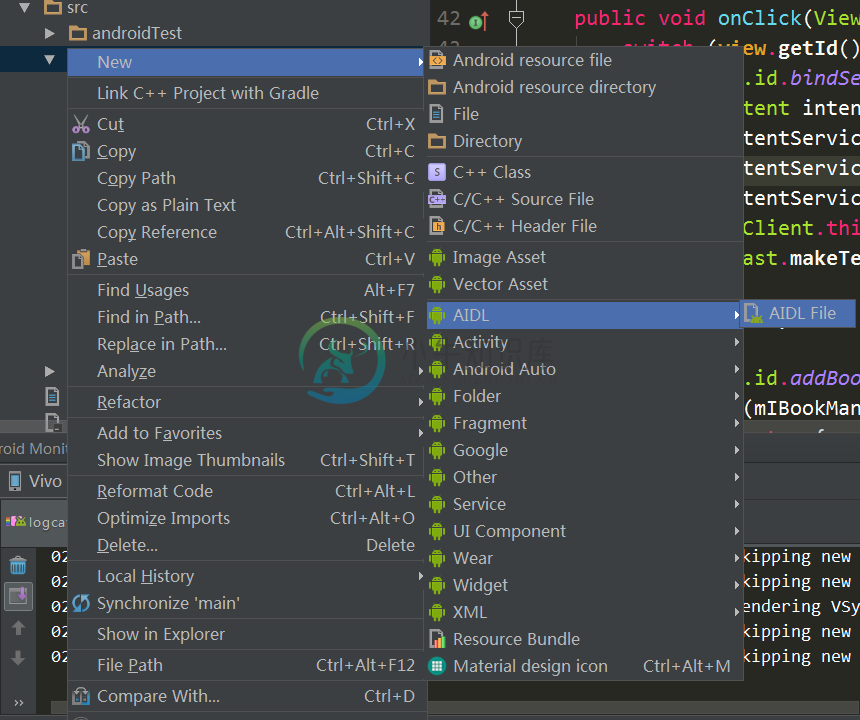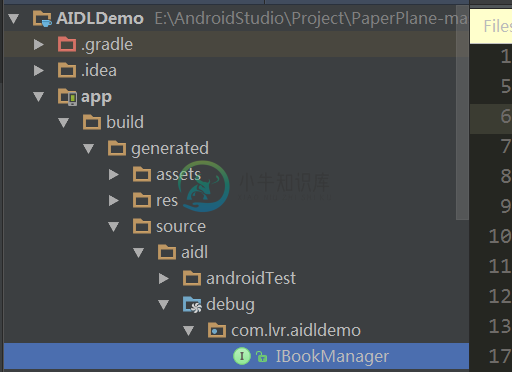3.2.4 Android Binder机制及AIDL使用
Binder原理
1、概述
Android系统中,涉及到多进程间的通信底层都是依赖于Binder IPC机制。例如当进程A中的Activity要向进程B中的Service通信,这便需要依赖于Binder IPC。不仅于此,整个Android系统架构中,大量采用了Binder机制作为IPC(进程间通信,Interprocess Communication)方案。
当然也存在部分其他的IPC方式,如管道、SystemV、Socket等。那么Android为什么不使用这些原有的技术,而是要使开发一种新的叫Binder的进程间通信机制呢?
为什么要使用Binder?
性能方面
在移动设备上(性能受限制的设备,比如要省电),广泛地使用跨进程通信对通信机制的性能有严格的要求,Binder相对于传统的Socket方式,更加高效。Binder数据拷贝只需要一次,而管道、消息队列、Socket都需要2次,共享内存方式一次内存拷贝都不需要,但实现方式又比较复杂。
安全方面
传统的进程通信方式对于通信双方的身份并没有做出严格的验证,比如Socket通信的IP地址是客户端手动填入,很容易进行伪造。然而,Binder机制从协议本身就支持对通信双方做身份校检,从而大大提升了安全性。
2、 Binder
IPC原理
从进程角度来看IPC(Interprocess Communication)机制

每个Android的进程,只能运行在自己进程所拥有的虚拟地址空间。例如,对应一个4GB的虚拟地址空间,其中3GB是用户空间,1GB是内核空间。当然内核空间的大小是可以通过参数配置调整的。对于用户空间,不同进程之间是不能共享的,而内核空间却是可共享的。Client进程向Server进程通信,恰恰是利用进程间可共享的内核内存空间来完成底层通信工作的。Client端与Server端进程往往采用ioctl等方法与内核空间的驱动进行交互。
Binder原理
Binder通信采用C/S架构,从组件视角来说,包含Client、Server、ServiceManager以及Binder驱动,其中ServiceManager用于管理系统中的各种服务。架构图如下所示:

Binder通信的四个角色
Client进程:使用服务的进程。
Server进程:提供服务的进程。
ServiceManager进程:ServiceManager的作用是将字符形式的Binder名字转化成Client中对该Binder的引用,使得Client能够通过Binder名字获得对Server中Binder实体的引用。
Binder驱动:驱动负责进程之间Binder通信的建立,Binder在进程之间的传递,Binder引用计数管理,数据包在进程之间的传递和交互等一系列底层支持。
Binder运行机制
图中Client/Server/ServiceManage之间的相互通信都是基于Binder机制。既然基于Binder机制通信,那么同样也是C/S架构,则图中的3大步骤都有相应的Client端与Server端。
注册服务(addService):Server进程要先注册Service到ServiceManager。该过程:Server是客户端,ServiceManager是服务端。
获取服务(getService):Client进程使用某个Service前,须先向ServiceManager中获取相应的Service。该过程:Client是客户端,ServiceManager是服务端。
使用服务:Client根据得到的Service信息建立与Service所在的Server进程通信的通路,然后就可以直接与Service交互。该过程:Client是客户端,Server是服务端。
图中的Client,Server,Service Manager之间交互都是虚线表示,是由于它们彼此之间不是直接交互的,而是都通过与Binder驱动进行交互的,从而实现IPC通信(Interprocess Communication)方式。其中Binder驱动位于内核空间,Client,Server,Service Manager位于用户空间。Binder驱动和Service Manager可以看做是Android平台的基础架构,而Client和Server是Android的应用层,开发人员只需自定义实现Client、Server端,借助Android的基本平台架构便可以直接进行IPC通信。
Binder运行的实例解释
首先我们看看我们的程序跨进程调用系统服务的简单示例,实现浮动窗口部分代码:
//获取WindowManager服务引用
WindowManager wm = (WindowManager) getSystemService(getApplication().WINDOW_SERVICE);
//布局参数layoutParams相关设置略...
View view = LayoutInflater.from(getApplication()).inflate(R.layout.float_layout, null);
//添加view
wm.addView(view, layoutParams);
注册服务(addService): 在Android开机启动过程中,Android会初始化系统的各种Service,并将这些Service向ServiceManager注册(即让ServiceManager管理)。这一步是系统自动完成的。
获取服务(getService): 客户端想要得到具体的Service直接向ServiceManager要即可。客户端首先向ServiceManager查询得到具体的Service引用,通常是Service引用的代理对象,对数据进行一些处理操作。即第2行代码中,得到的wm是WindowManager对象的引用。
使用服务: 通过这个引用向具体的服务端发送请求,服务端执行完成后就返回。即第6行调用WindowManager的addView函数,将触发远程调用,调用的是运行在systemServer进程中的WindowManager的addView函数。
使用服务的具体执行过程

- Client通过获得一个Server的代理接口,对Server进行调用。
- 代理接口中定义的方法与Server中定义的方法是一一对应的。
- Client调用某个代理接口中的方法时,代理接口的方法会将Client传递的参数打包成Parcel对象。
- 代理接口将Parcel发送给内核中的Binder Driver。
- Server会读取Binder Driver中的请求数据,如果是发送给自己的,解包Parcel对象,处理并将结果返回。
- 整个的调用过程是一个同步过程,在Server处理的时候,Client会Block住。因此Client调用过程不应在主线程。
AIDL的使用
1.AIDL的简介
AIDL (Android Interface Definition Language) 是一种接口定义语言,用于生成可以在Android设备上两个进程之间进行进程间通信(Interprocess Communication, IPC)的代码。如果在一个进程中(例如Activity)要调用另一个进程中(例如Service)对象的操作,就可以使用AIDL生成可序列化的参数,来完成进程间通信。
简言之,AIDL能够实现进程间通信,其内部是通过Binder机制来实现的,后面会具体介绍,现在先介绍AIDL的使用。
2.AIDL的具体使用
AIDL的实现一共分为三部分,一部分是客户端,调用远程服务。一部分是服务端,提供服务。最后一部分,也是最关键的是AIDL接口,用来传递的参数,提供进程间通信。
先在服务端创建AIDL部分代码。
AIDL文件 通过如下方式新建一个AIDL文件

默认生成格式
interface IBookManager {
/**
* Demonstrates some basic types that you can use as parameters
* and return values in AIDL.
*/
void basicTypes(int anInt, long aLong, boolean aBoolean, float aFloat,
double aDouble, String aString);
}
默认如下格式,由于本例要操作Book类,实现两个方法,添加书本和返回书本列表。
定义一个Book类,实现Parcelable接口。
public class Book implements Parcelable {
public int bookId;
public String bookName;
public Book() {
}
public Book(int bookId, String bookName) {
this.bookId = bookId;
this.bookName = bookName;
}
public int getBookId() {
return bookId;
}
public void setBookId(int bookId) {
this.bookId = bookId;
}
public String getBookName() {
return bookName;
}
public void setBookName(String bookName) {
this.bookName = bookName;
}
@Override
public int describeContents() {
return 0;
}
@Override
public void writeToParcel(Parcel dest, int flags) {
dest.writeInt(this.bookId);
dest.writeString(this.bookName);
}
protected Book(Parcel in) {
this.bookId = in.readInt();
this.bookName = in.readString();
}
public static final Parcelable.Creator<Book> CREATOR = new Parcelable.Creator<Book>() {
@Override
public Book createFromParcel(Parcel source) {
return new Book(source);
}
@Override
public Book[] newArray(int size) {
return new Book[size];
}
};
}
由于AIDL只支持数据类型:基本类型(int,long,char,boolean等),String,CharSequence,List,Map,其他类型必须使用import导入,即使它们可能在同一个包里,比如上面的Book。
最终IBookManager.aidl 的实现
// Declare any non-default types here with import statements
import com.lvr.aidldemo.Book;
interface IBookManager {
/**
* Demonstrates some basic types that you can use as parameters
* and return values in AIDL.
*/
void basicTypes(int anInt, long aLong, boolean aBoolean, float aFloat,
double aDouble, String aString);
void addBook(in Book book);
List<Book> getBookList();
}
注意:如果自定义的Parcelable对象,必须创建一个和它同名的AIDL文件,并在其中声明它为parcelable类型。
Book.aidl
// Book.aidl
package com.lvr.aidldemo;
parcelable Book;
以上就是AIDL部分的实现,一共三个文件。
然后Make Project ,SDK为自动为我们生成对应的Binder类。
在如下路径下:

其中该接口中有个重要的内部类Stub ,继承了Binder 类,同时实现了IBookManager接口。 这个内部类是接下来的关键内容。
public static abstract class Stub extends android.os.Binder implements com.lvr.aidldemo.IBookManager{}
服务端 服务端首先要创建一个Service用来监听客户端的连接请求。然后在Service中实现Stub 类,并定义接口中方法的具体实现。
//实现了AIDL的抽象函数
private IBookManager.Stub mbinder = new IBookManager.Stub() {
@Override
public void basicTypes(int anInt, long aLong, boolean aBoolean, float aFloat, double aDouble, String aString) throws RemoteException {
//什么也不做
}
@Override
public void addBook(Book book) throws RemoteException {
//添加书本
if (!mBookList.contains(book)) {
mBookList.add(book);
}
}
@Override
public List<Book> getBookList() throws RemoteException {
return mBookList;
}
};
当客户端连接服务端,服务端就会调用如下方法:
public IBinder onBind(Intent intent) {
return mbinder;
}
就会把Stub实现对象返回给客户端,该对象是个Binder对象,可以实现进程间通信。 本例就不真实模拟两个应用之间的通信,而是让Service另外开启一个进程来模拟进程间通信。
<service
android:name=".MyService"
android:process=":remote">
<intent-filter>
<category android:name="android.intent.category.DEFAULT" />
<action android:name="com.lvr.aidldemo.MyService" />
</intent-filter>
</service>
android:process=":remote"设置为另一个进程。<action android:name="com.lvr.aidldemo.MyService"/>是为了能让其他apk隐式bindService。通过隐式调用的方式来连接service,需要把category设为default,这是因为,隐式调用的时候,intent中的category默认会被设置为default。
客户端
首先将服务端工程中的aidl文件夹下的内容整个拷贝到客户端工程的对应位置下,由于本例的使用在一个应用中,就不需要拷贝了,其他情况一定不要忘记这一步。
客户端需要做的事情比较简单,首先需要绑定服务端的Service。
Intent intentService = new Intent();
intentService.setAction("com.lvr.aidldemo.MyService");
intentService.setPackage(getPackageName());
intentService.setFlags(Intent.FLAG_ACTIVITY_NEW_TASK);
MyClient.this.bindService(intentService, mServiceConnection, BIND_AUTO_CREATE);
Toast.makeText(getApplicationContext(), "绑定了服务", Toast.LENGTH_SHORT).show();
将服务端返回的Binder对象转换成AIDL接口所属的类型,接着就可以调用AIDL中的方法了。
if (mIBookManager != null) {
try {
mIBookManager.addBook(new Book(18, "新添加的书"));
Toast.makeText(getApplicationContext(), mIBookManager.getBookList().size() + "", Toast.LENGTH_SHORT).show();
} catch (RemoteException e) {
e.printStackTrace();
}
}
3.AIDL的工作原理
Binder机制的运行主要包括三个部分:注册服务、获取服务和使用服务。 其中注册服务和获取服务的流程涉及C的内容,由于个人能力有限,就不予介绍了。
本篇文章主要介绍使用服务时,AIDL的工作原理。
①.Binder对象的获取
Binder是实现跨进程通信的基础,那么Binder对象在服务端和客户端是共享的,是同一个Binder对象。在客户端通过Binder对象获取实现了IInterface接口的对象来调用远程服务,然后通过Binder来实现参数传递。
那么如何维护实现了IInterface接口的对象和获取Binder对象呢?
服务端获取Binder对象并保存IInterface接口对象 Binder中两个关键方法:
public class Binder implement IBinder {
void attachInterface(IInterface plus, String descriptor)
IInterface queryLocalInterface(Stringdescriptor) //从IBinder中继承而来
..........................
}
Binder具有被跨进程传输的能力是因为它实现了IBinder接口。系统会为每个实现了该接口的对象提供跨进程传输,这是系统给我们的一个很大的福利。
Binder具有的完成特定任务的能力是通过它的IInterface的对象获得的,我们可以简单理解attachInterface方法会将(descriptor,plus)作为(key,value)对存入Binder对象中的一个Map对象中,Binder对象可通过attachInterface方法持有一个IInterface对象(即plus)的引用,并依靠它获得完成特定任务的能力。queryLocalInterface方法可以认为是根据key值(即参数 descriptor)查找相应的IInterface对象。
在服务端进程,通过实现private IBookManager.Stub mbinder = new IBookManager.Stub() {}抽象类,获得Binder对象。 并保存了IInterface对象。
public Stub() {
this.attachInterface(this, DESCRIPTOR);
}
客户端获取Binder对象并获取IInterface接口对象
通过bindService获得Binder对象
MyClient.this.bindService(intentService, mServiceConnection, BIND_AUTO_CREATE);
然后通过Binder对象获得IInterface对象。
private ServiceConnection mServiceConnection = new ServiceConnection() {
@Override
public void onServiceConnected(ComponentName name, IBinder binder) {
//通过服务端onBind方法返回的binder对象得到IBookManager的实例,得到实例就可以调用它的方法了
mIBookManager = IBookManager.Stub.asInterface(binder);
}
@Override
public void onServiceDisconnected(ComponentName name) {
mIBookManager = null;
}
};
其中asInterface(binder)方法如下:
public static com.lvr.aidldemo.IBookManager asInterface(android.os.IBinder obj) {
if ((obj == null)) {
return null;
}
android.os.IInterface iin = obj.queryLocalInterface(DESCRIPTOR);
if (((iin != null) && (iin instanceof com.lvr.aidldemo.IBookManager))) {
return ((com.lvr.aidldemo.IBookManager) iin);
}
return new com.lvr.aidldemo.IBookManager.Stub.Proxy(obj);
}
先通过queryLocalInterface(DESCRIPTOR);查找到对应的IInterface对象,然后判断对象的类型,如果是同一个进程调用则返回IBookManager对象,由于是跨进程调用则返回Proxy对象,即Binder类的代理对象。
②.调用服务端方法
获得了Binder类的代理对象,并且通过代理对象获得了IInterface对象,那么就可以调用接口的具体实现方法了,来实现调用服务端方法的目的。
以addBook方法为例,调用该方法后,客户端线程挂起,等待唤醒:
@Override public void addBook(com.lvr.aidldemo.Book book) throws android.os.RemoteException
{
..........
//第一个参数:识别调用哪一个方法的ID
//第二个参数:Book的序列化传入数据
//第三个参数:调用方法后返回的数据
//最后一个不用管
mRemote.transact(Stub.TRANSACTION_addBook, _data, _reply, 0);
_reply.readException();
}
..........
}
省略部分主要完成对添加的Book对象进行序列化工作,然后调用transact方法。
Proxy对象中的transact调用发生后,会引起系统的注意,系统意识到Proxy对象想找它的真身Binder对象(系统其实一直存着Binder和Proxy的对应关系)。于是系统将这个请求中的数据转发给Binder对象,Binder对象将会在onTransact中收到Proxy对象传来的数据,于是它从data中取出客户端进程传来的数据,又根据第一个参数确定想让它执行添加书本操作,于是它就执行了响应操作,并把结果写回reply。代码概略如下:
case TRANSACTION_addBook: {
data.enforceInterface(DESCRIPTOR);
com.lvr.aidldemo.Book _arg0;
if ((0 != data.readInt())) {
_arg0 = com.lvr.aidldemo.Book.CREATOR.createFromParcel(data);
} else {
_arg0 = null;
}
//这里调用服务端实现的addBook方法
this.addBook(_arg0);
reply.writeNoException();
return true;
}
然后在transact方法获得_reply并返回结果,本例中的addList方法没有返回值。
客户端线程被唤醒。因此调用服务端方法时,应开启子线程,防止UI线程堵塞,导致ANR。

